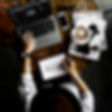

RECYCLING STORIES THROUGH ELECTRONIC DEVICES
Creative Phase Activities
Techniques & Tutorials
SOUVENIR BOOK
Material needed
- A4 black sheets,
- A3 white sheets,
- glue sticks,
- scissors,
- pens, pencils, markers,
- inks and pads,
-- blotting paper sheets,
- crayons,
- white sheets,
- magazines,
- paper tape,
- transparent adhesive tape,
- stamps with letters or others objects that can leave a print.
Objectives
1. Explore art techniques to facilitate storytelling
2. Translate feelings and relate them to an emotional map
3. Better visual education and visual composite skills
4. Fix contents and create report by accessible tools
5. Find new ways to catalog things for different needs
Time frame
90 minutes
Tips
To use this creative technique in addition to photos gathered during the discovery phase, you will also need small objects or fragments of objects.
Creating a souvenir book is way to make small and seemingly insignificant details memorable and valuable. At the same time, within this tiny object you can also catalog plenty of techniques to keep traces, you can turn them into a story or into messages to the future yourself. The possibilities are nearly infinite.

To create a Souvenir Book, you should collect some traces such as natural items from a walk, tiny objects, scraps of papers and things alike. To take inspiration on how to collect traces, see the activity called Creative City Crossing.
Once you have your collection of traces, you can reassemble them to create your own Souvenir Book following these suggestions.
1. Prepare the base of the Souvenir Book. Starting from a white A3 sheet and following this pattern of folds, you can get a small book consisting of 4 pages.



2. Customize your own Souvenir Book. Choose and place among the pages the traces of the city that you have collected, looking for your own style and your own narrative thread and using various creative techniques.

3. The idea is to compose a two-dimensional collage with the mixed media technique. Traces on the book can be glued, transferred, photocopied, drawn, written, but also torn: the only rule is that any trace transferred on it should not create thickness in the pages.






4. In addition to writing, drawing or sticking traces into the pages of your book, your can use these 4 image transfer techniques we suggest:
- frottage (rubbing a wax pastel on a sheet to catch rough surfaces)
- printing (using ink and tampons to let objects leave their print)
- contouring (retracing the perimeter of an object to create a silhouette of it)
- tape scrapping (using adhesive tape to "steal" words and textures from paper by putting the tape on a paper and then peeling it off very quickly).

5. Create an exhibition. Afterwards, each Souvenir Book is placed on a black sheet and a small exhibition is organized, so you can share the work done with others and give the occasion to those who want to tell about their own experience and their personal crossing of the city.

Recommendations to combine "Souvenir Book" with other activities:
CREATIVE CITY CROSSING